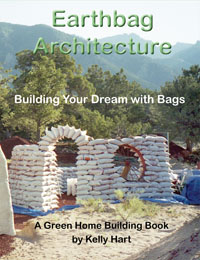EarthbagBuilding.com
Sharing information and promoting earthbag building
| Home | History | Resources | Slide Show |
| About Us | Projects | Plans | Videos |
| Blog | FAQ's | Workshops | Testing |
| Search | Articles | Bulletin Board | Shelter |
| Doing a Jar Test for Soil Composition Questions answered by Kelly Hart |
Q: When I did the jar test (5 times in different areas), I found that in all test I only had a 1/8 '' line of clay at the top which would equate to about 1%. So my next question is this: When I process my soil for filling the sandbags and mixing the cob, (I plan to pile up a big pile of sand and put into a small cement mixer about {10} 3# coffee cans full of sand) How much Portland cement or lime should I add to the mixture? And which is preferable cement or lime? 50 years in the aerospace industry, several phases of engineering and I feel so stupid. A: The requirements for cob are much more stringent than for the earthbags. You really need the clay in there to bind it all together for cob. I suppose that you could add enough cement or lime to serve this purpose, but this would not be true cob; it would be more like a soil-cement mix. This is a dry pack (moist) earth/cement mixture which works especially well with rather sandy soil, but will also work with other soil types. The heavier soils with more clay content will probably require more portland cement. Soil cement has been used to form walls, make floors, pave roads, stabilize river banks, etc. Here is some information about formulas for soil cement: Make it by mixing earth with Portland cement to the desired depth, add water and mix again. Tamp, and cover with plastic to let it cure properly. Use 6 to 16 percent cement by volume according to the density of the soil. The denser the soil (clay, for instance), the higher percentage of cement to use. Six percent translates to 1 part cement to 15 parts soil; 16 percent translates to 1 part cement to 6 parts soil. The cement could be replaced by hydrated lime, and this would be more environmentally benign since there is a net zero CO2 emission associated with it, but this will not be quite as hard and durable as cement. I would recommend doing some experiments before committing to this for a large project. For filling the earthbags, you could also do this, but I question whether it is really worth all of the trouble. Nader Khalili only considered the bagging material as a temporary form for adobe (thus super adobe). He liked the idea that the bags could rot away and the building would still stand. But in order for this to be true, the bags need to be filled with a hardening material. A whole other approach is to fill your bags with your native soil (unaltered), allow the polypropylene (which is incredibly strong) to remain as a containing skin, and protect the bag material with a plaster (which you were probably going to do anyway). In order for this approach to be viable, you have to protect the bags from the UV in the sun as much as possible, so you would want to tarp them when you are not working on the wall. I built my whole house this way (filling the bags with crushed volcanic stone...which is better insulation than soil) and it is still standing after 10 years and will probably stand for at least another century I believe.
A: I would expect this to be excellent soil for using in earthbags, or other earthen building projects, such adobe, cob or rammed earth. If you dampen the soil slightly before filling the bags and compact it well, the earthbags should become nearly rock hard and be quite durable. In this circumstance, the bag material becomes less important to keep the structure erect. Do you recommend doing a soil sample first? Yes, if you run a soil sample test, you might discover that there is enough clay to bind the soil together. Or you can moisten some of the soil and see if it will form a cohesive ball, or just fragments once it is dry. |
See Your Ad |
Disclaimer of Liability and Warranty
We specifically disclaim any warranty, either expressed or implied, concerning the information on these pages. No one associated with this site will have liability for loss, damage, or injury, resulting from the use of any information found on this or any other page at this site.
For Email contact go to About Us
We are interested in communication from others who are exploring the possibilities inherent with earthbag building.
Visit Our Other Websites:
www.greenhomebuilding.com
www.dreamgreenhomes.com
www.naturalbuildingblog.com

 Q: My wife and I finally managed to spend a bit of time on the land we bought in Georgia over the weekend, and we took some soil samples and did the settling test on them. To me it looks as if I've got about even thirds sand, silt, and clay, but I wanted to bounce the pictures off of somebody with more experience. The pictures are attached. Does this seem like a reasonable soil mix for earthbag building?
Q: My wife and I finally managed to spend a bit of time on the land we bought in Georgia over the weekend, and we took some soil samples and did the settling test on them. To me it looks as if I've got about even thirds sand, silt, and clay, but I wanted to bounce the pictures off of somebody with more experience. The pictures are attached. Does this seem like a reasonable soil mix for earthbag building? 